Lucia Lee
Last update: 13/10/2025
It’s no secret that effective stock management is the backbone of ecommerce success - either overstock or stockouts can hurt your bottom line and destroy customer trust. At the end of the day, success comes down to how well you can predict what your customers want and when they want it, which is the core concept of demand forecasting. In this post, we dive deep into demand forecasting, from how it works and why it matters to how you can use it to drive ecommerce growth.
Ecommerce demand forecasting is the process of predicting how much of a product customers will want to buy in the future. It’s a vital part of demand planning, helping businesses align their inventory with demand for stock optimization. By leveraging data analysis - which includes examining historical sales, seasonal trends, consumer behavior, and other external factors - companies can make informed decisions about what, when, and how much to stock.
Accurate ecommerce demand forecasting depends on understanding a range of internal and external factors that can shift market behavior, including:
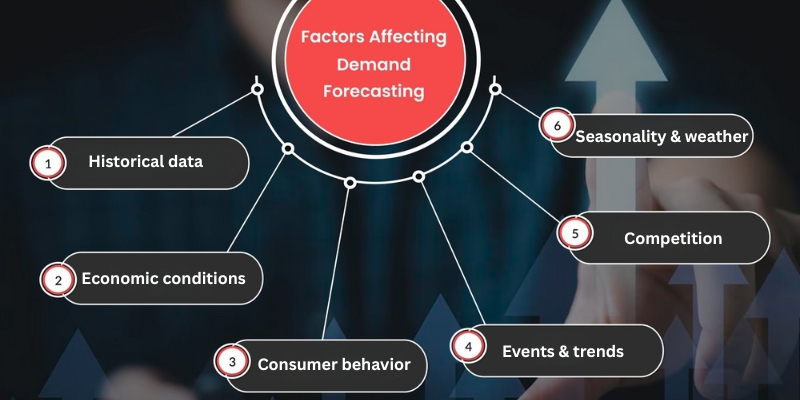
Factors that influence ecommerce demand forecasts
Historical data
Past performance often provides the clearest signal for future demand. By analyzing sales trends from previous months or years, businesses can identify recurring patterns, seasonal spikes, and slow periods.
Economic conditions
The overall economy, which is affected by factors like inflation rates, government regulations, and interest rates, plays a huge role in shaping demand. For example, during economic downturns or recessions, customers tend to cut back on non-essential items and delay purchases.
Consumer behavior
Ecommerce demand can shift dramatically based on how consumers think and act. Social media trends, viral campaigns, and shifting cultural interests can suddenly boost or reduce demand for specific products.
Seasonality and weather
Market demand for many products follows clear seasonal cycles. For example, gift items peak during holidays, outerwear sells more in winter, and outdoor equipment sees a spike in sales in summer. Weather patterns can also drive unexpected surges or drops - for instance, rainwear during a wet season or cooling appliances during a heatwave.
Also read: The Future of AI in Ecommerce: Top Trends To Watch
Competition
Actions by competitors - such as launching new products, adjusting prices, or running promotions - can significantly influence your ecommerce demand forecasting. A sudden discount from a rival brand can divert customers, while a competitor’s stockout may drive traffic to your store.
Events and emerging trends
Major events like holidays, sports tournaments, or cultural movements can all shape consumer demand. Likewise, emerging market trends or shifts in social sentiment can create new buying behaviors almost overnight.
Whether you’re a global retailer or a small online shop, the impact of accurate demand forecasting is huge. Let’s explore why ecommerce demand forecasting has become a must-have rather than a nice-to-have:
Smarter inventory management
One of the biggest advantages of ecommerce demand forecasting is improved inventory management. By analyzing past sales data and identifying purchasing patterns, businesses can maintain the right stock levels - not too much, not too little. This helps avoid both stockouts, which frustrate customers, and excess inventory that ties up capital and storage space. When you understand demand patterns, every item on your shelf serves a purpose.
Better stock optimization
Forecasting demand gives ecommerce retailers the power to achieve stock optimization across multiple sales channels. With accurate insights, brands can allocate inventory to the right warehouses or regions, ensuring fast delivery and minimizing logistical costs.
Enhanced supply chain efficiency
A solid forecasting system directly strengthens supply chain management. By anticipating customer demand, businesses can plan production, procurement, and fulfillment cycles more effectively. Suppliers can be informed in advance, shipping schedules can be streamlined, and warehouse operations can run smoothly. This visibility prevents bottlenecks and enables seamless order fulfillment even when market conditions shift unexpectedly.

Enhanced supply chain efficiency
Boosted revenue and profitability
Accurate ecommerce demand forecasting plays a vital role in revenue forecasting and helps guide pricing and promotional strategies. When businesses can predict how products will perform, they can make data-driven decisions to boost profitability. Understanding demand surges allows ecommerce brands to adjust dynamic pricing, maximize margins, and capture more value during high-demand periods - all while avoiding wasteful markdowns during slower times.
Improved marketing and sales strategies
Ecommerce demand forecasting empowers marketing teams with precise sales prediction and order forecasting insights. When you know what products are likely to trend, you can design smarter campaigns, promote bestsellers at the right time, and align ad spend with periods of high demand. It transforms marketing from reactive to strategic, helping your brand engage customers with the right products - just when they’re ready to buy.
Increased customer satisfaction
When your stock levels match customer expectations, satisfaction naturally follows. Accurate forecasts ensure products are always available, delivery is faster, and fulfillment is smooth. Customers don’t face frustrating “out of stock” messages, and your brand builds trust through reliability.
Scalable growth and long-term stability
Finally, ecommerce demand forecasting sets the stage for demand planning that supports scalable growth. Whether expanding into new markets or adding product lines, forecasting helps ecommerce businesses grow without losing control of operations.
For years, businesses have relied on traditional demand forecasting models built on spreadsheets, historical data, and human judgment. While these methods have served as a foundation for planning, they’re no longer enough in today’s fast-changing ecommerce landscape - where viral trends, sudden weather shifts, or supply chain disruptions can reshape demand overnight.
That’s where AI demand forecasting comes in, transforming prediction from a static exercise into a dynamic, data-driven advantage. Let’s look at how AI models differ from traditional ones - and why they’re becoming essential for modern businesses.
Broader, real-time data sources
Traditional forecasting mainly relies on historical sales data and seasonal patterns - essentially, what worked yesterday is assumed to work tomorrow. But AI takes it further.
AI-powered forecasting systems integrate real-time external signals such as social media sentiment, weather updates, regional trends, and competitor pricing to build a more holistic picture of demand.
That means if a product suddenly goes viral on TikTok or there’s a storm that boosts raincoat sales, AI systems can detect and react to those shifts before they appear in your sales reports. By blending internal metrics with external data, AI provides demand sensing for online stores in a way that traditional models cannot.
Continuous learning and automatic updates
Traditional forecasting models are static - they only update when humans tell them to, often on a weekly or monthly schedule. This creates delays that can cost businesses accuracy and agility.
AI ecommerce demand forecasting, by contrast, learns continuously. Machine learning algorithms retrain themselves automatically as new data flows in, refining predictions in real time. When market conditions flip overnight - say, due to an economic downturn or a viral product surge - AI models immediately adjust. This responsiveness helps ecommerce businesses stay ahead, even when consumer behavior changes unexpectedly.
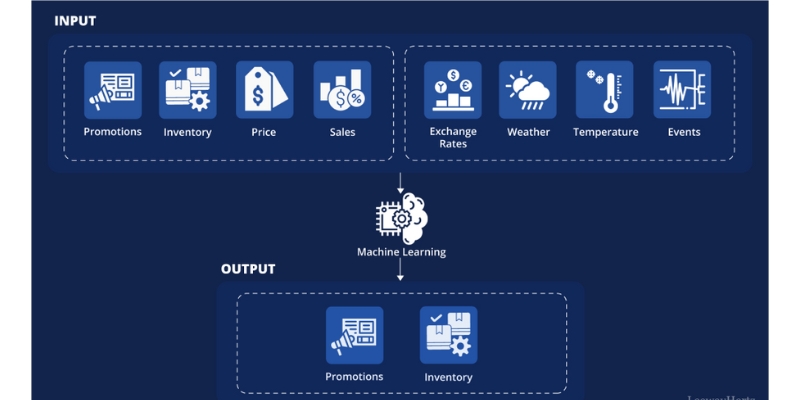
Continuous learning and automatic updates
Higher accuracy and granular insights
Traditional models often forecast at the category or weekly level, which can leave room for large safety stock buffers or missed opportunities. AI-based demand prediction models, on the other hand, deliver SKU-, store-, and even daily-level predictions, allowing for far more precise inventory management and demand planning.
This enhanced accuracy minimizes both overstock and stockouts, helping businesses optimize warehouse space, cash flow, and customer satisfaction. Some large retailers now generate billions of micro-predictions weekly, powering smarter replenishment systems that respond instantly to demand signals.
Scalability and efficiency
One of the biggest challenges with traditional ecommerce demand forecasting is scalability. As a business grows, managing and updating multiple spreadsheets becomes tedious and error-prone.
AI eliminates that bottleneck. Instead of hiring more analysts, AI simply needs more data to scale. Whether you’re a growing online brand or a global enterprise, AI forecasting tools expand seamlessly across product lines and markets. This automation also reduces manual workloads, freeing your team to focus on strategic decisions rather than data crunching.
From guesswork to guided precision
Ultimately, traditional forecasting helps you understand where you’ve been, while AI helps you see where you’re going. By combining massive data sets with adaptive learning, AI turns uncertainty into opportunity - predicting not only what customers will buy, but why and when.
Ecommerce demand forecasting isn’t a one-size-fits-all process. There are several types of forecasting, and the right approach depends on your goals, your growth stage, and how volatile your market is. Let’s take a closer look at each type:
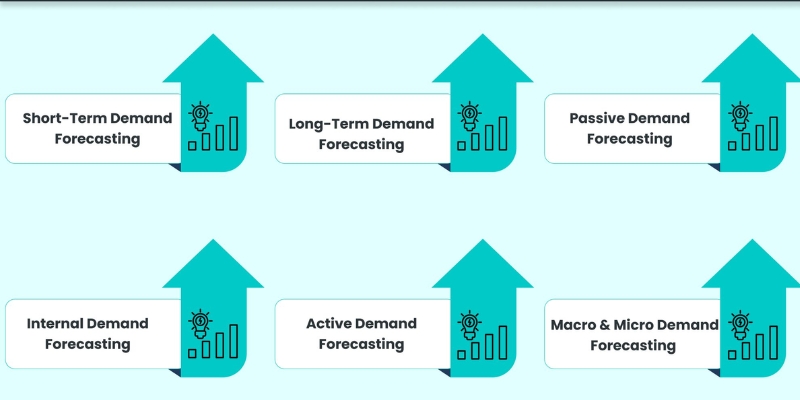
Types of ecommerce demand forecasting
Passive demand forecasting
Passive demand forecasting is the simplest form - it relies entirely on historical sales data to predict what will happen next. For example, you might use last year’s holiday sales to estimate this year’s demand during the same season.
This model is great for established businesses operating in stable markets, where demand patterns don’t change dramatically from year to year. However, it may not perform well in fast-moving or unpredictable industries where consumer preferences shift quickly.
Active demand forecasting
Unlike passive forecasting, the active approach looks beyond historical data. It incorporates external variables such as marketing campaigns, consumer sentiment, and economic trends to make predictions that reflect real-time dynamics. This model is especially valuable for startups or brands in high-growth phases that need to respond quickly to changes in demand.
Internal (micro-level) forecasting
Internal forecasting focuses on what’s happening inside your business. It looks at operational factors like inventory levels, profit margins, employee productivity, and supply chain performance to gauge how well your business can meet expected demand.
This approach is particularly useful for optimizing production schedules and improving operational efficiency, though it doesn’t account for external disruptions such as market downturns or competitor innovations.
External (macro-level) forecasting
External forecasting takes a broader, big-picture perspective. It studies global trends, economic indicators, and industry-wide shifts to understand how external forces could influence your ecommerce performance. This forecasting type is essential for businesses expanding into new regions or navigating competitive, fast-changing industries.
Short-term demand forecasting
Short-term forecasting usually covers a period from a few weeks up to a year. It helps ecommerce businesses stay responsive to quick market changes - whether it’s preparing for peak shopping seasons like Black Friday or adjusting inventory after a viral product surge. As this method focuses on near-term activity, it’s ideal for day-to-day operational decisions such as marketing campaigns, restocking, and staffing.
Long-term demand forecasting
Long-term forecasting stretches the horizon, typically projecting one to five years into the future. It’s less about precision and more about strategic direction - helping ecommerce leaders shape expansion plans, product development strategies, and investment decisions. Although long-term forecasts can’t account for every market twist, they’re invaluable for mapping growth trajectories and preparing for different business scenarios.
Choosing the right forecasting method can make or break your ability to predict customer demand accurately. Let’s explore what methods and techniques are there and the pros and cons of each:
Qualitative forecasting
When historical data is limited or unavailable - such as with new product launches - qualitative methods step in. These approaches rely on expert opinions, customer insights, and market research to estimate future demand. Market research is one of the most common qualitative techniques. Through surveys, interviews, and focus groups, businesses can uncover who their customers are, what drives their purchasing decisions, and how their preferences evolve over time.
While qualitative forecasting can be time-consuming and costly, it provides deep, human-centered insights that numbers alone can’t capture. It’s particularly effective for understanding emerging trends and aligning marketing strategies with real customer needs.
Time series analysis and projection
Time series forecasting is one of the most widely used quantitative methods in ecommerce. It leverages historical sales data to detect patterns, trends, and seasonality over time.
A simple form of this is trend projection, where past sales figures are extended forward to predict future performance. However, this approach requires careful adjustment for anomalies - like economic downturns or sudden spikes - to avoid misleading results.
Time series methods are ideal for established products with stable sales patterns, helping businesses plan inventory, manage resources, and maintain consistency in their supply chain.
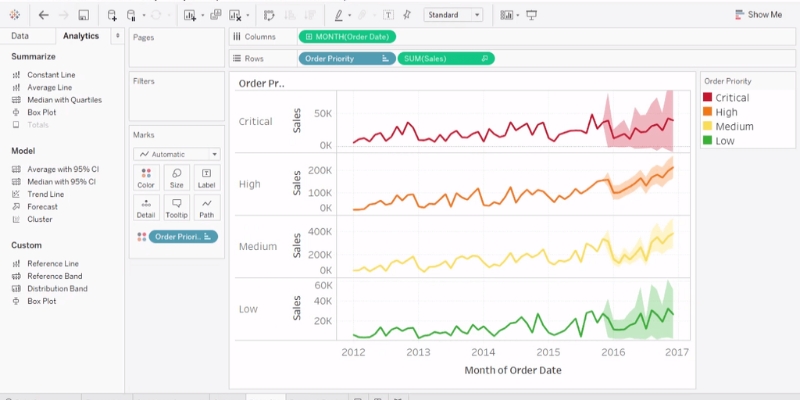
Time series analysis and projection
Causal forecasting
Causal models go beyond past sales to explore the relationships between multiple factors influencing demand - from marketing spend and product price to macroeconomic conditions.
For instance, econometric models use statistical equations to measure how changes in one variable (like advertising budget) impact another (such as sales volume). This makes them particularly effective for long-term ecommerce demand forecasting and identifying turning points in the market.
Causal forecasting is perfect for businesses seeking to understand why demand changes, not just when, enabling more strategic decisions across operations, marketing, and pricing.
Machine learning and AI-based forecasting
AI and machine learning have revolutionized ecommerce demand forecasting. These systems analyze vast, complex datasets - from website traffic and social media mentions to pricing trends and seasonal behavior - and automatically refine predictions over time. This approach is especially valuable for large businesses managing diverse product catalogs and dealing with volatile demand patterns influenced by promotions or external events.
Hybrid and ensemble models
No single forecasting method fits every situation - and that’s where hybrid models come in. These approaches combine multiple techniques to balance precision and flexibility. By blending methods, businesses can minimize weaknesses in any single approach and produce more robust, accurate forecasts. Hybrid models are particularly effective for enterprises managing large, dynamic product portfolios where different SKUs follow different demand drivers.
Accurate ecommerce demand forecasting doesn’t happen by chance - it follows a structured process combining data, analysis, and constant refinement. While methods may differ across businesses, the following steps form the foundation of an effective ecommerce forecasting strategy.
Define your goals
Start by clarifying why you’re forecasting. Are you trying to optimize inventory, improve marketing decisions, or plan long-term growth? Clear goals determine what type of forecast you’ll build - short-term vs. long-term, product-level vs. macro - and what accuracy level is needed. Without this clarity, the rest of your forecasting process becomes guesswork.
Identify available data
Next, assess what information you already have and what additional data you can gather. This includes historical sales, web traffic, CRM insights, and market trends. Integrate both internal and external data sources to enrich the accuracy of your model.
Collect and clean your data
Reliable forecasts rely on reliable data. Collect relevant data from ecommerce platforms, analytics tools, and surveys, then clean it to remove duplicates, fill missing values, and standardize formats. This step ensures your analysis isn’t skewed by inconsistencies or inaccuracies.
Apply the right forecasting method
Selecting the right forecasting approach is critical as every business, product, and market behaves differently. Factors like data availability, product lifecycle, and market volatility all influence which approach will deliver the most meaningful insights. You can also combine methods to ensure your forecasts are accurate enough to guide decisions, but flexible enough to adapt as your business evolves.
Interpret and communicate the results
Ecommerce demand forecasting isn’t just about numbers - it’s about context. When you share results, explain assumptions, confidence levels, and possible errors. It’s important to provide stakeholders with clear insights on how to act on the forecast, rather than just reporting figures.
Track performance and refine continuously
The most accurate forecasts come from continuous learning. Regularly compare predictions with actual results, analyze deviations, and adjust your model accordingly. Over time, this iterative approach builds stronger, more reliable ecommerce demand forecasting accuracy.
Demand forecasting may be one of the most powerful tools in ecommerce, but it’s far from simple. Understanding the challenges you may face helps you prepare for them and ultimately build more resilient, adaptable forecasting systems.
Data quality and accessibility
Reliable forecasting begins with reliable data, but for many businesses, gathering clean, complete, and consistent data is easier said than done. Information is often spread across multiple systems like Shopify, Amazon, and in-store platforms, each using different formats and metrics. These data silos make it difficult to form a unified view of sales and inventory.
In addition, historical records may be incomplete, inconsistent, or poorly maintained, especially if they weren’t originally collected for forecasting purposes. This “bad recordkeeping” can make integrating data into forecasting software time-consuming and error-prone.
Also read: Data Management with AI: Everything You Need to Know
Rapidly changing consumer behavior
Consumer preferences evolve faster than ever, influenced by social media trends, global events, and shifting cultural values. These constant changes make it challenging to predict demand with precision.
Traditional models that rely heavily on historical data tend to fall short in this environment. By the time patterns are recognized, the market may already have moved on.
Over-reliance on historical data
Historical sales figures are essential for ecommerce demand forecasting, but depending on them too much can create blind spots. Consumer behavior, marketing strategies, and external conditions evolve, which means what sold well last year might not perform the same today.
Relying solely on past sales ignores external variables like competitor actions, new technologies, or economic fluctuations. This makes forecasts overly simplistic and often inaccurate.
Demand volatility and market uncertainty
In today’s unpredictable landscape, demand can fluctuate overnight. Seasonal peaks, promotional events, and sudden global disruptions can all send forecasts off course. Even small shifts in consumer confidence or social sentiment can cause major ripples in demand patterns.
For ecommerce businesses, this volatility makes it hard to maintain the right stock levels. Too much inventory ties up capital, while too little risks stockouts and lost sales.
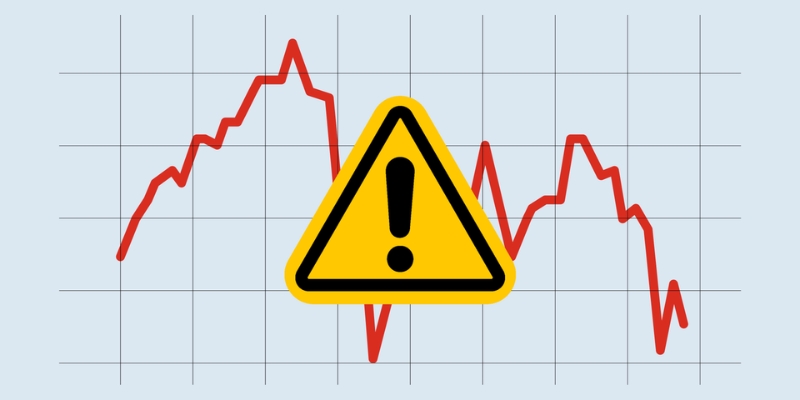
Demand volatility and market uncertainty
Fragmented systems and legacy technology
Many businesses still rely on outdated tools and disconnected systems that make data consolidation a nightmare. When software platforms don’t communicate or share standardized data, forecasting teams waste valuable time manually collecting and cleaning information.
Legacy systems also limit scalability. As businesses grow, these older infrastructures can’t keep up with the complexity of multi-channel operations. The result is slower decision-making and reduced visibility, both of which undermine forecasting accuracy and responsiveness.
Limited visibility into consumer behavior
Even with robust data, predicting what consumers will do remains one of the toughest challenges. Shoppers’ motivations, emotions, and situational factors are difficult to quantify, especially when using traditional models.
Without tools to analyze behavioral signals - such as browsing habits, cart abandonment rates, or social sentiment - businesses miss valuable context behind purchase decisions. This lack of visibility often leads to forecasts that capture what customers buy but not why they buy it, limiting the ability to anticipate future trends.
Supply chain complexity and uncertain lead times
Ecommerce demand forecasting doesn’t happen in a vacuum - it’s tightly connected to supply chain performance. When suppliers face unpredictable lead times, raw material shortages, or transportation delays, even accurate demand predictions can become irrelevant.
Getting demand forecasting right isn’t an easy task, but with the tried-and-true best practices below, you can forecast demand more accurately and strategically:
Keep your data fresh and reliable
Your forecast is only as accurate as the data behind it. Regularly updating your models with real-time data, conducting regular data audits, and validating your sources will help. Don’t let outdated or dirty data throw off your inventory plans and budgeting decisions.
Also read: How to Improve Data Quality: 10 Practical Strategies to Adopt
Leverage predictive analytics for smarter forecasts
Predictive analytics takes ecommerce demand forecasting to the next level by using advanced algorithms to identify patterns and predict future behavior.
By integrating predictive analytics into your forecasting process, you can make more confident decisions on inventory planning, pricing strategies, and marketing campaigns.
Use the best demand forecasting software
Modern ecommerce demand forecasting thrives on technology. Using the best demand forecasting software gives you the ability to analyze massive datasets, detect hidden patterns, and automate repetitive tasks. These tools often integrate seamlessly with your existing systems - from CRM and ERP to web analytics platforms - providing a single source of truth for all your demand data.
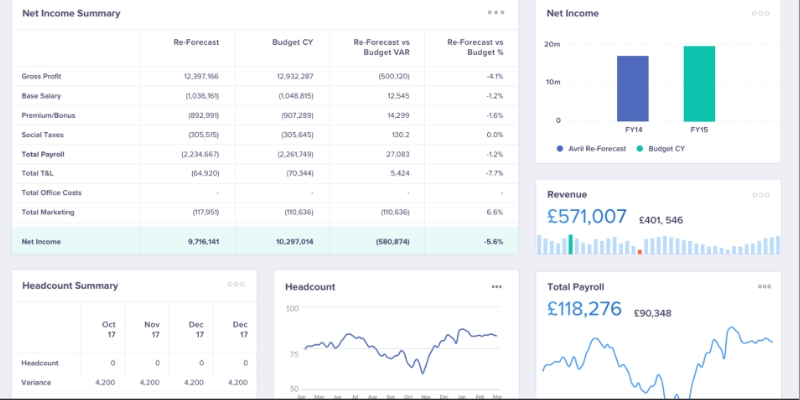
Use the best demand forecasting software
Combine multiple forecasting methods
No single model fits all scenarios. Combining qualitative insights with quantitative models gives you a more holistic and dependable view of future demand. For example, you might pair time series analysis for stable products with expert opinions or market research for new launches.
This multi-method approach helps verify your predictions, identify anomalies, and reduce bias. It also ensures that your forecasts stay balanced - grounded in data but guided by real-world experience.
Monitor seasonality and emerging trends
Seasonality can make or break your ecommerce performance. Analyzing historical sales cycles helps you recognize predictable peaks and dips so you can adjust inventory and marketing strategies accordingly.
At the same time, stay alert to emerging consumer trends and macroeconomic shifts. Keeping an eye on changing shopping habits, competitor moves, and global events allows you to pivot quickly and stay one step ahead of demand fluctuations.
Collaborate across teams and partners
Ecommerce demand forecasting shouldn’t happen in isolation. Collaborate with sales, marketing, and supply chain teams to incorporate diverse insights into your models. This cross-functional collaboration ensures your forecasts reflect both internal goals and external realities, creating a more accurate and actionable view of future demand.
Continuously review and refine your forecasts
Demand forecasting isn’t a “set it and forget it” process. As market dynamics shift, revisit your forecasts regularly to ensure they remain relevant. Incorporate feedback from actual sales data, stock levels, and campaign results to fine-tune your assumptions.
Accurate ecommerce demand forecasting isn’t just about predicting numbers - it’s about building a smarter, more resilient ecommerce operation.
At Sky Solution, we help ecommerce brands turn data into direction with AI-powered tools that make forecasting, inventory, and growth easier to manage. Discover how our ecommerce solutions can help your business plan smarter and sell better - contact us now for a free consultation and start today!